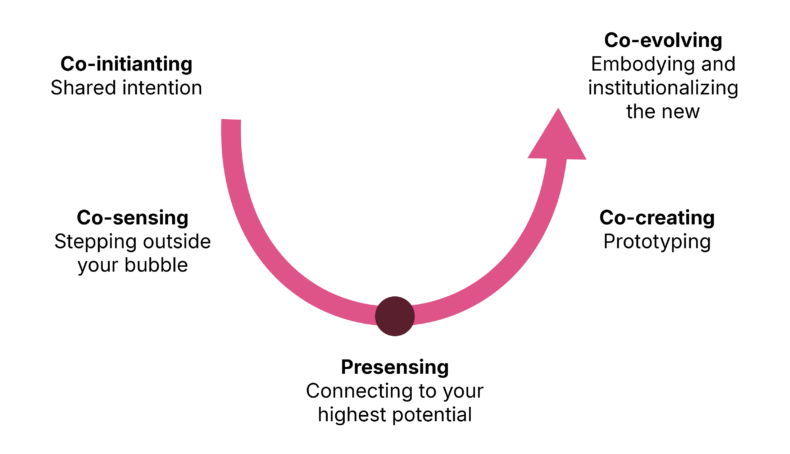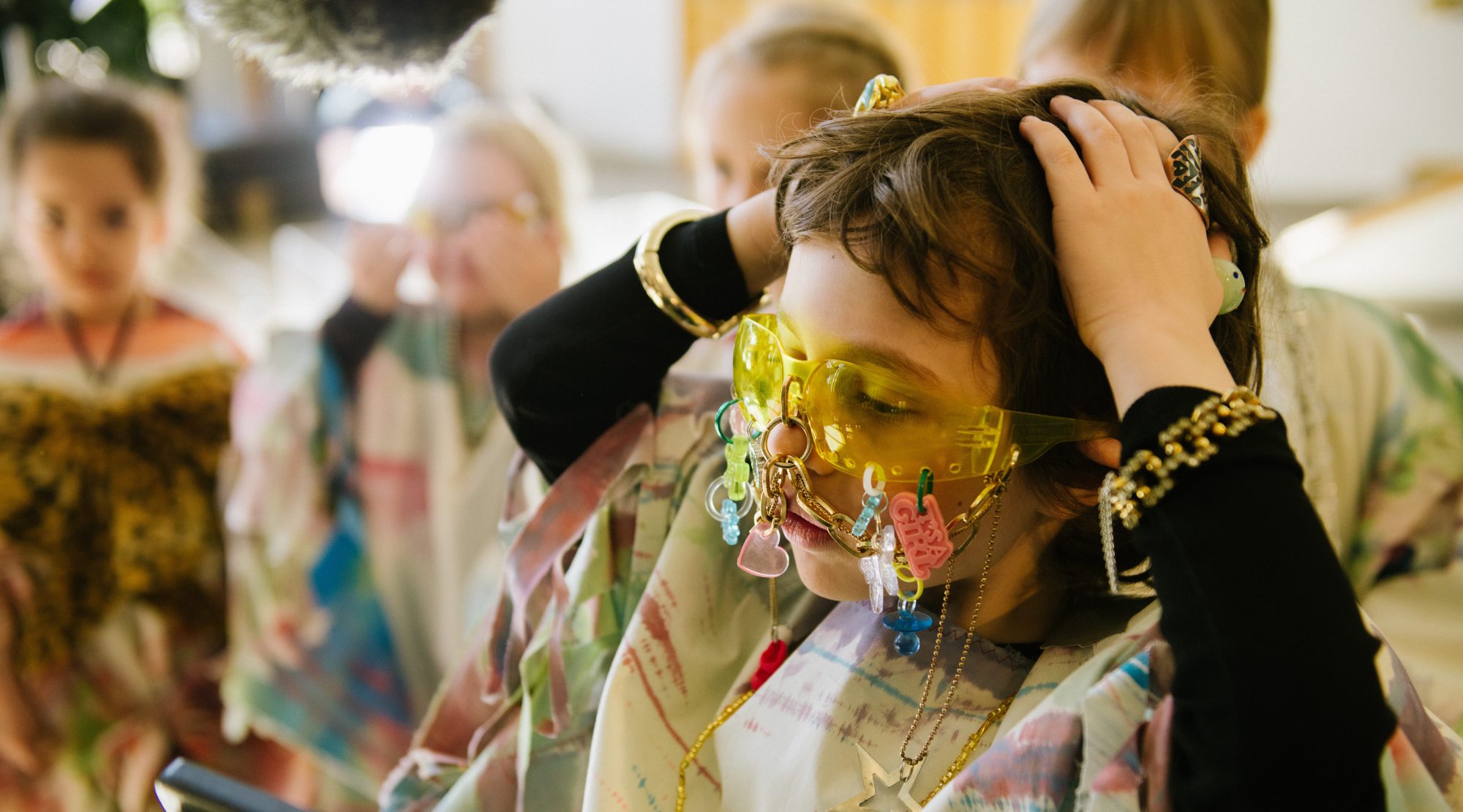What future is coming into being? How do personal and collective transformation support the pursuit of sustainable development goals?
To really change the future and address the planetary crises that our societies faces, we need systemic change. Promoting this transformation is not only about high-level intellectual reasoning but also about our ability to connect with something that can be understood through physical sensation and intuition. It’s something bigger than ourselves: the interconnected local and global ecological and social systems that are too complex for humans to fully know or manage.
Transformative change is a living process directly linked to action. Values are not just thoughts and ideas. Values are not separate from our actions. How we act in relation to others, to the environment and to the future is how our values are manifested.
As a radical creative, you need to do your own inner work. But the essential level of transformative work is the team, community, organization or network, where you can cultivate the multi-dimensional intelligence and the capacity for co-creation of groups, which is an essential level of systemic change.
Building the right conditions for sustainable future
The future unfolds in unexpected ways
According to Otto Scharmer, a Senior Lecturer at MIT and a leading systems thinker, systems change is a big challenge for collective decision-making and creativity. How do we move away from just reacting in response to the issues of the past and instead start sensing and actualizing the future that’s waiting to emerge? And how do we do that in a way that bridges today’s ecological, social and spiritual divides?
Certain conditions or circumstances motivate people to strive to transcend the prevailing ways of thinking and acting. How can we create conditions that don’t lead to the reproduction of pre-existing values, norms and beliefs but instead encourage a different quality of interaction between the individual, the community, the ‘more-than-human’ reality and the world at large?
The future unfolds in unexpected ways, which is why we need to learn to let go of old patterns of thought and behavior and allow for the emergence of new and innovative behaviours and ideas. This is the future coming into being, the concept that is described in Otto Scharmer’s book, Theory U: Leading from the Future as it Emerges. The journey from ego-system to eco-system awareness, or from ‘me’ to ‘we’ requires better relating to others, to the whole system and to oneself.
Watch Otto Scharmer’s talk below. If the video doesn’t show, you can watch it here.
Quiz
Well done! You have successfully completed this assignment.
Vision of the future
Earth goals and inner goals
But first, what is the future we are envisioning? While each of us may have our personal vision of what we would expect to happen next, at the global level, all the United Nations Member States adopted the 2030 Agenda for Sustainable Development in 2015. It is a shared agreement for peace and prosperity for people and the planet, now and in the future. At its heart are the 17 Sustainable Development Goals (SDGs), which call for immediate action from the world’s countries in a global partnership.
It’s noteworthy that the 17 SDGs are highly interdependent. This makes the application of a systemic perspective increasingly important in addressing sustainability problems.
To accompany the 17 SDGs, a non-profit initiative based in Sweden has created a set of Inner Development Goals (IDG), that presents five dimensions of inner transformation skills needed to contribute to sustainable development goals (SDGs), as follows:
- Being. This set of skills is related to the relationship to yourself. It includes abilities such as integrity and authenticity, openness, a learning mindset and self-awareness.
- Thinking. This is about your cognitive skills—critical thinking, complexity awareness and perspective skills. Also, it’s about the ability to have a long-term orientation and vision.
- Relating. This is about the ability to care for others and the world through humility, appreciation, empathy and compassion.
- Collaborating or social skills, such as communication skills, trust, an inclusive mindset and intercultural competence.
- Acting. Doing something concrete to enable change through courage, creativity, optimism and perseverance.
These five dimensions of inner skills are important to cultivate as we work towards the Sustainable Development Goals. Inner skills not only enhance individuals’ well-being, self-esteem and creativity but also strengthen teamwork, promote innovation and increase the ability of a community or organisation to navigate an uncertain and changing environment and generate systemic change.
Case study
Teaching creative sustainability
Well done! You have successfully completed this assignment.
Inner transformation as a group
Theory U framework
Otto Scharmer3 has developed a framework for systems change, which he calls Theory U. It involves moving through a process represented by the Theory U framework, which includes five stages: co-initiating, co-sensing, presencing, co-creating and co-evolving.
Most learning methodologies focus on past experiences. Otto Scharmer’s Theory U is a framework and method that shifts the focus to the future. It enables individuals and groups to shape a future that isn’t a repetition of the present and the past. It helps people to get their old habits and conscious mind out of the way to allow real creativity to arise.
By activating deeper levels of knowing and learning, people gain awareness of the larger whole, leading to actions that can help shape its evolution and future. The Theory U framework involves moving through a process that includes five stages:
Co-initiating is about opening your mind towards a shared intention of what you want to create with others. This also involves forming the core team and establishing contacts with interesting players.
Co-sensing is about seeing reality from the edges of the system. You’ll have to step outside your bubble and immerse yourself in contexts that are relevant for creating the possible future and that are new to you. At the end of this phase, you’ll listen through your heart and revise your thinking:
What do you want to create? Why does it matter? How will you achieve your goal?
Presencing is about connecting to your highest future potential. You connect with your sources of creativity and self. Questions like ‘who is my self?’ and ‘what is my work?’ take you to your higher self from where the future purpose emerges.
Co-creating is about prototyping with different future initiatives. Feedback sessions are an important aspect of this process.
Co-evolving is about embodying and institutionalizing the new. At this stage, you and your core team members will decide what prototype will advance to the pilot phase. You’ll create infrastructures and ecosystems to scale the new idea. You’ll create narratives about societal renewal.
To sum up, as visualized below in Figure 5.3.1, on the left-hand side of the U (co-initiating and co-sensing) people let go of their preconceptions and collect information from far and wide. At the bottom of the U is presencing, the space of being with the unknown and listening to deeper wisdom of the system. On the right-hand side of the U (co-creating and co-evolving) people develop new ideas and prototype and test them.

Reflection
Can you change?
Well done! You have successfully completed this assignment.
Becoming radically creative
How to find your path towards changing the world?
To end this sub-chapter, we’ll hear from two people who are devoting their professional and personal lives to systemic change. Maria Joutsenvirta is a learning designer specialized in transformative learning processes, and Ricardo Dutra Gonçalves is a university lecturer at Aalto whose main interest is in developing arts-based pedagogies.
What kind of wisdom would they like to share about how to become more radically creative?
‘Yes, I have to do my own inner work, but for me, radical creativity is very much a relational act: Who am I with others? How do I show up to the world with others is what matters, really’, says Joutsenvirta.
For her, radical creativity is about untapped human potential. ‘There’s so much in us that kind of gets stuck or blocked by current structures or the current culture of how things are or should be.’
Dutra Gonçalves refers to bell hooks, an influential American author, professor, feminist and social activist. ‘She advocates for such education that empowers students to wander away from racial, sexual and class boundaries so they can achieve the sense of freedom.’ And this freedom is where radical creativity can emerge.
Gonçalves also calls for concrete practices: ‘Not just reading or theorizing but doing some embodied practices. There’s lots of research that shows how embodied action can also help you change in the level of the brain.’
Both thinkers and activist believe that there is a lot to learn from the field of art.
‘Finding the artist in you would be good advice,’ says Joutsenvirta. ‘Art offers the ability to imagine. To imagine that we have other futures that we can bring into this present moment. Then start constructing them or living these more sustainable futures.’
Real-life activity
Day of listening
Well done! You have successfully completed this assignment.
Keywords
Impact, future, future coming into being, Sustainable Development Goals, Inner Development Goals, being, thinking, relating, collaborating, acting, co-initiating, co-sensing, presencing, co-creating, co-shaping.
References
- Aalto University resource: Capacity Building of Creative Radicals development project in Aalto University. Published online at: https://www.aalto.fi/en/embodied-practices-for-teams/capacity-building-of-creative-radicals-removing-barriers-to-organisational-creativity
- bell hooks, (1997). Teaching to Transgress: Education as the Practice of Freedom. Routledge.
- Scharmer, O. (2018). The Essentials of Theory U: Core Principles and Applications. Berrett-Koehler Publishers, Incorporated
5. Impact
In this chapter, we explore how radical creativity impacts our lives, both individually and as a society, by bringing about significant changes for the better.
5.1 Systemic impact
You’ll learn about systemic impact and the key players involved in driving radically creative outcomes.
5.2 Paradigm shifting
You’ll explore how new assumptions and mindsets shape policies and societies, including examples of paradigm shifts in economic theories over time.
5.3 Future coming into being
You’ll understand personal and collective transformation as the foundation for creating a sustainable future, reflecting inner skills of creativity.
5.4 Changing the world for better
You’ll gain insights into various future scenarios while learning foresight methodologies and how creative practices support transformative futures.
5.5 Novelty and innovation
You’ll examine incremental, disruptive and radical innovation, understanding the distinctions between radical creativity and innovation. You’ll also learn how an interorganizational approach drives creativity.
